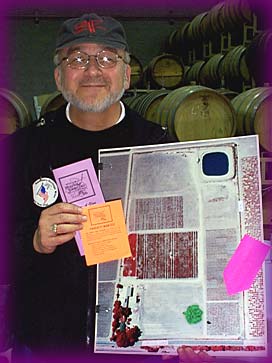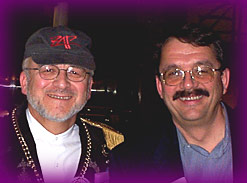
 |
Richard Flores, ZAP board member
and keeper of the Adopt-A-Vine program, displays the
Heritage Vineyard plat.
Be sure to check out the
Zinfandel in America timeline! |
"The ZINFANDEL HERITAGE VINEYARD is
an amazing project for ZAP and the University of California Davis. Every vine represent
living examples of our county's agricultural and cultural heritage. Think of it, we
know that the journey for each of these vines started in Europe -- likely each from
a unique political jurisdiction. Earlier clones made their way across oceans and vast land
masses, always vulnerable on the their environment and care of others. Now, we have
them all securely rooted together here in California. They are doing just fine :-)
"
Richard Flores
BACKGROUNDER:
THE HERITAGE VINEYARD
Source: Zinfandel Advocates & Producers
 |
Richard Flores and James Wolpert |
The Heritage
Vineyard is an unusual and unprecedented collection of rare
and `famous' Zinfandel vine cuttings from all over California. A research team consisting
of UC Davis' Prof. James Wolpert (Chair, Viticulture & Enology Department), UC Extension
Viticulturist Emeritus Armand Kasimatis and UC Extension Farm Advisors Ed Weber (in Napa County) and Rhonda Smith (in
Sonoma County) began going on Zinfandel `safaris' in 1989, searching for vineyards planted
before 1930. They brought back clippings from Sonoma, Mendocino, Napa, Contra Costa, the
Sierra Foothills and San Luis Obispo and San Joaquin Counties. They looked for vines with
looser clusters and smaller Zinfandel berries than in the Zinfandels currently certified
by the University. Why?
"It's our responsibility as vineyardists, winemakers, craftsmen and `keepers of the
flame' that we seek out the purest and finest quality clones of Zinfandel in California,
isolate them, nurture them, study them and then possibly make them available commercially
on a large scale, all to insure that Zinfandel moves into the next millennium in its most
superb incarnation," explains winemaker Kent
Rosenblum. "The Heritage Vineyard brings us
all together as scientists, farmers, artists and historians," adds Rebecca Robinson,
Executive Director, ZAP. "Ultimately, this research will help us discover answers to
some of the mysteries surrounding Zinfandel and preserve the special qualities of the old
vines for future generations," Wolpert adds, who directs all of the research at the Heritage Vineyard.
The Heritage Vineyard stretches over 0.76 acres within the University of California, Davis' Oakville (Napa Valley)
Research Station. It contains 7 vines each from
63 different Zinfandel vineyards, with 456 vines currently planted in the bale clay loam
soils. The vines are grafted onto St. George rootstock. The spacing is 9' x 8' [vine x
row]. Each vine is head-trained and spur-pruned in the "goblet" shape as they
would have been in the nineteenth century. These practices are not as typical today, since
they insure a low (and high quality) yield. The Heritage Vineyard requires authenticity:
"we need to replicate the conditions which have given Zinfandel its reputation,"
Wolpert explains.
The vines in the Heritage Vineyard were specifically chosen by the researchers because they
were known to produce unique and high quality wines. However, it is not clear whether
their uniqueness is due to the clone of Zinfandel or the site, climate, soil and cultural
practices. These differences will become clearer now that the vines have been collected in
one site and will be farmed under a uniform set of practices. "By following variables
such as cluster weight, berry size and cluster tightness," Wolpert says, "we can
determine which might be genetic and which are due to other factors." The researchers
have also planted three clones of Zinfandel currently certified by UC Davis' Foundation
Plant Material Services.
The Heritage Vineyard will establish a body of information about Zinfandel which
will support the quality of Zinfandel grown in the future. "The quality of Zin will
not be compromised," says winemaker Joel
Peterson (Ravenswood). "We all base our
winemaking on great fruit, and our goal in the Heritage Vineyard is to speed up the clock
on research," he adds.
"The Heritage Vineyard is a vibrant `ongrowing' museum of the grape," explains
Mary Buckles Pisor, assistant winemaker at Saddleback Cellars in Oakville. Nils Venge and Mary Buckles Pisor
made the first Heritage Vineyard Zinfandel from the 1997 harvest at Saddleback. "The
Vineyard is of tremendous historical and viticultural interest to those fascinated by
Zinfandel," she adds. "For the consumer, the Vineyard is living history and
provides an easily accessible demonstration of where Zinfandel is really made---in the
vineyard. For the wine industry, it has special significance because it represents a
resource for future plantings of Zinfandel with a broad range of selections."
Research will also encompass virus testing of the plant material, which runs approximately
$1,500 per vine. Eventually the most desirable clones will be released to the industry
through UC Davis.
In August 1998 ZAP donated $25,000 to the Heritage
Vineyard. "This could easily be the largest
grant coming from an independent organization focused on one specific wine-grape
varietal," Wolpert said when he accepted the check from Joel Peterson and Rebecca Robinson.
"This research will potentially have more impact on the improvement of Zinfandel than
any other study done at UC Davis. I am very grateful to ZAP because without their advice,
involvement and financial support this trial would not be possible," he added.
"These funds are the proceeds of ZAP's 1998
Blue Jeans To Black Tie Auction," Robinson
announced.
Zinfandel has a unique spot in American cultural history as well as American viticulture.
There are a number of aspects to this: for example, Zinfandel is the only wine grape
varietal considered to be unique to the U.S. by the B.A.T.F. It once was the most widely
planted varietal in California. Zinfandel is possibly the most stylistically diverse wine
made in the U.S., and so on.
PARENTS WANTED!
ADOPT-A-VINE. Each of the vines are older than 50 years. Some have
been producing fruit for more than 100 years. The Heritage Vineyard will soon
become a historic destination. ZAP is encouraging individuals to become
Adopt-A-Vine parents and participate in the scientific study and scheduled
activities in the historic vineyard. Adoption levels are:
 ZIN Parent:
$50 donation adopts one zinfandel "old vine" for one year ZIN Parent:
$50 donation adopts one zinfandel "old vine" for one year
 ZIN Family: $100 donation
adopts three zinfandel "old vines" for one year ZIN Family: $100 donation
adopts three zinfandel "old vines" for one year
 ZIN Scholar: $150
donation adopts one zinfandel "old vine" to vintage 2000 ZIN Scholar: $150
donation adopts one zinfandel "old vine" to vintage 2000
Donations are tax deductible.
For more information on how to adopt a vine, contact Richard
Flores
Please check out the facinating Zin in America timeline too!
   

|


